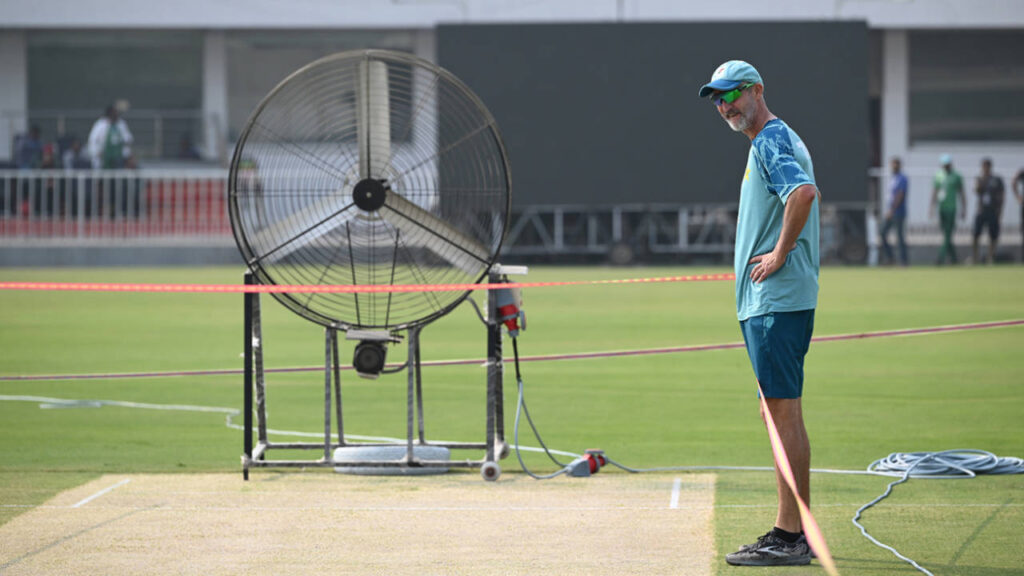Pakistan’s intent for the Rawalpindi pitch has become quite evident. Even before the conclusion of the second Test, Aleem Dar and Aqib Javed were already en route to Rawalpindi to supervise preparations for the upcoming game.
Following the Multan Test, Shan Masood made it clear in a press conference that he hoped the Pindi surface would offer a significant turn. Within a few days, the pitch was surrounded by massive industrial heaters, which are frequently used for outdoor events in Pakistan’s winter months. To speed up the process, windbreakers and strong fans were also installed.
This careful preparation was noted by England, who were perplexed by Pakistan’s spinners in Multan.
England’s Harry Brook suggested that the Rawalpindi pitch had been intentionally “raked” by the groundstaff to expedite its wear and tear, thereby bringing the spinners into play earlier.
In response, England adjusted their lineup, including only one specialist seamer, Gus Atkinson, while introducing legspinner Rehan Ahmed.
Pakistan’s efforts to create a turning wicket at Rawalpindi are more challenging compared to Multan, as the pitch at Pindi doesn’t naturally aid spinners. In contrast, Multan’s surface had already been used, which made it easier to prepare. Shan Masood, along with vice-captain Saud Shakeel, acknowledged that they’ve rarely seen the Pindi track offer turn. However, Shakeel expressed hope for a different outcome this time.
“There’s a significant difference between Multan and Pindi,” Shakeel noted. “Multan is much warmer and more humid, while Pindi’s cooler conditions favor fast bowlers with more bounce. The groundsmen prepare the pitches accordingly, and that’s where the differences arise.”
Shakeel emphasized that after the success in Multan, Pakistan will attempt to prepare a similar surface in Rawalpindi, hoping it will benefit their spinners and help secure a victory. Since Pakistan’s return from the UAE, there has been a consistent debate about how best to utilize home conditions. Initially, Pakistan shifted away from spin-friendly pitches, aiming to develop tracks that supported seamers. This aligned with the rise of young fast bowlers like Shaheen Afridi and Naseem Shah, who delivered promising performances early on, including Naseem’s five-wicket haul against Sri Lanka and Shaheen’s decisive contribution in a series against South Africa.
Read Also: Pakistan Test Squad Conducts First Practice Session Ahead of Rawalpindi Test
However, Pakistan’s fortunes took a nosedive when they decided to prepare a docile surface in Rawalpindi ahead of a Test against Australia, a decision that marked the end of seam-friendly tracks at home. Over the next 11 matches, Pakistan failed to win a single game, losing seven of those encounters. This winless streak only ended recently with Pakistan’s victory on a crumbling pitch in Multan.
This experience seems to have prompted a rethink within the Pakistan Cricket Board (PCB). “We’ve realized a bit late that we need to approach pitches on a series-by-series, match-by-match basis,” Shakeel explained. “If we need to prepare for SENA (South Africa, England, New Zealand, Australia) conditions, we can do that in our first-class cricket or practice sessions. But when it comes to international series, we should tailor our pitches according to the opposition.”
The morale-boosting win in the second Test has given Pakistan confidence, and Shakeel is eager to once again give the spinners a leading role. Zahid Mahmood, the legspinner, struggled in Multan, bowling only six overs in the entire match despite favorable conditions. This could slightly open the door for the inclusion of a specialist seamer, though with England fielding three spinners, it seems unlikely.
“We haven’t finalized our XI yet,” Shakeel added. “If the pitch turns, we may opt for three spinners again, but it depends on the surface and conditions on the day.”
